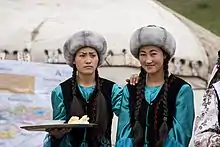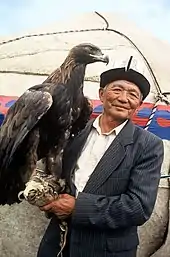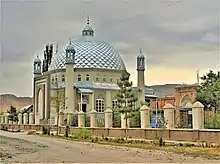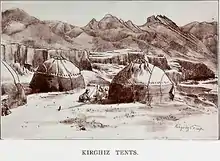кыргыздар qyrğyzdar قىرغىزدار | |
|---|---|
 Kyrgyz falconer in the Barskoon valley | |
| Total population | |
| c. 5–6 million | |
| Regions with significant populations | |
| 4.9 million[a][1][2] | |
| 450,000[3] | |
| 202,500[4] | |
| 137,780[5] | |
| 62,000 | |
| 23,274[6] | |
| 2,000[7][8] | |
| 1,600 | |
| 1,130[9] | |
| 1,128[10] | |
| 1,055[11] | |
| 6,607[12] | |
| Languages | |
| Kyrgyz | |
| Religion | |
Predominantly Islam[13][14]
| |
^a At the 2009 census, ethnic Kyrgyz constituted roughly 71% of population of Kyrgyzstan (5.36 million). | |
The Kyrgyz people (also spelled Kyrghyz, Kirgiz, and Kirghiz; UK: /ˈkɪərɡɪz/ KEER-giz US: /kərˈɡiːz/ kər-GEEZ)[19] are a Turkic ethnic group native to Central Asia. They are primarily found in Kyrgyzstan, Uzbekistan, China, Pakistan and Afghanistan.[lower-alpha 1] A Kyrgyz diaspora is also found in Russia, Tajikistan, and Kazakhstan. They speak the Kyrgyz language, which is the official language of Kyrgyzstan.
The earliest Kyrgyz people were the descendants of several central Asian tribes, first emerging in western Mongolia around 201 BC. Modern Kyrgyz people are descended from the Yenisei Kyrgyz that lived in the Yenisey river valley in Siberia. The Kyrgyz people were constituents of the Tiele people, the Göktürks, and the Uyghur Khaganate before establishing the Yenisei Kyrgyz Khaganate in the 9th century, and later a Kyrgyz khanate in the 15th century.[20][21][22]
Historical notice: in Russian Empire several nomad peoples in Central Asia were collectively known as "Kirgizs". The correct identification was introduced during the national delimitation in the Soviet Union.
Etymology
There are several theories on the origin of ethnonym Kyrgyz. It is often said to be derived from the Turkic word kyrk ("forty"), with -iz being an old plural suffix, so Kyrgyz literally means "a collection of forty tribes".[23] It also means "imperishable", "inextinguishable", "immortal", "unconquerable" or "unbeatable", as well as its association with the epic hero Manas, who – according to a founding myth – unified the 40 tribes against the Khitans. A rival myth, recorded in 1370 in the History of Yuan, concerns 40 women born on a steppe motherland.[24]
.jpg.webp)
The earliest records of the ethnonym appear to have been the Chinese transcriptions Gekun (鬲昆, LH *kek-kuən < Old Chinese: *krêk-kûn) and Jiankun (堅昆, LH *ken-kuən < OC: *kên-kûn). Those suggest that the original ethnonym was *kirkur ~ kirgur and/or *kirkün, and another transcription Jiegu (結骨, EMC: *kέt-kwət) suggests *kirkut / kirgut. Yury Zuev proposed that the ethnonym possibly means 'field people, field Huns' (cf. Tiele tribal name 渾 Hún < MC *ɣuən).[25] Peter Golden reconstructs *Qïrğïz < *Qïrqïz< *Qïrqïŕ and suggests a derivation from Old Turkic qır 'gray' (horse color) plus suffix -q(X)r/ğ(X)r ~ k(X)z/g(X)z.[26][27] Besides, Chinese scholars later used a number of different transcriptions for the Kyrgyz people: these include Gegu (紇骨), Jiegu (結骨), Hegu (紇骨), Hegusi (紇扢斯), Hejiasi (紇戛斯), Hugu (護骨), Qigu (契骨), or Juwu (居勿), and then, during the reign of Tang Emperor Wuzong, Xiajiasi (黠戛斯), said to mean "red face".[28][29] Edwin G. Pulleyblank surmises that "red face" was possibly a folk etymology provided by an interpreter who explained the ethnonym based on Turkic qïzïl ~ qizqil, meaning 'red'.[30] By the time of the Mongol Empire, the ethnonym's original meaning had apparently been forgotten – as was shown by variations in readings of it across different reductions of the History of Yuan. This may have led to the adoption of Kyrgyz and its mythical explanation.
During the 18th and 19th centuries, European writers used the early Romanized form Kirghiz – from the contemporary Russian киргизы – to refer not only to the modern Kyrgyz, but also to their more numerous northern relatives, the Kazakhs. When distinction had to be made, more specific terms were used: the Kyrgyz proper were known as the Kara-Kirghiz ("Black Kirghiz", from the colour of their tents),[31] and the Kazakhs were named the Kaisaks.[32][33] or "Kirghiz-Kazaks".[31]
Origins

The Kyrgyz are a Turkic ethnic group. Recent linguistic, genetic and archaeological evidence suggests that the earliest Turkic peoples descended from agricultural communities in Northeast China who moved westwards into Mongolia in the late 3rd millennium BC, where they adopted a pastoral lifestyle.[34][35][36][37][38] By the early 1st millennium BC, these peoples had become equestrian nomads.[34] In subsequent centuries, the steppe populations of Central Asia appear to have been progressively Turkified by an East Asian dominant minority moving out of Mongolia.[39][40]
The early Kyrgyz people, known as the Yenisei Kyrgyz, have their origins in the western parts of modern-day Mongolia and first appear in written records in the Chinese annals of the Sima Qian's Records of the Grand Historian (compiled 109-91 BCE) as Gekun (鬲昆, 隔昆) or Jiankun (堅昆).[28] The Middle Age Chinese composition Tang Huiyao of the 8–10th century transcribed the name "Kyrgyz" as Jiegu (Kirgut), and their tamga was depicted as identical to the tamga of present-day Kyrgyz tribes Azyk, Bugu, Cherik, Sary Bagysh and few others.[41]

According to recent historical findings, Kyrgyz history dates back to 201 BC.[42] The Yenisei Kyrgyz lived in the upper Yenisey River valley, central Siberia. In late antiquity, the Yenisei Kyrgyz were a part of the Tiele people. Later, in the Early Middle Ages, the Yenisei Kyrgyz were a part of the confederation of the Göktürks and the Uyghur Khaganate.
In 840, a revolt led by the Yenisei Kyrgyz brought down the Uyghur Khaganate, and brought the Yenisei Kyrgyz to a dominating position in the former Second Turkic Khaganate. With the rise to power, the center of the Kyrgyz Khaganate moved to Jeti-su, and brought about a spread south of the Kyrgyz to Tian Shan and Xinjiang, bringing them into contact with the existing peoples of what is now Western China, especially the Tibetan Empire.
The khagans of the Yenisei Kirghiz Khaganate claimed descent from the Han Chinese general Li Ling, which was mentioned in the diplomatic correspondence between the Kirghiz khagan and the Tang Dynasty emperor, since the Tang imperial Li family claimed descent from Li Ling's grandfather, Li Guang. The Kirghiz qaghan assisted the Tang dynasty in destroying the Uyghur Khaganate and rescuing the Princess Taihe from the Uyghurs. They also killed a Uyghur khagan in the process.
Then Kyrgyz quickly moved as far as the Tian Shan range and maintained their dominance over this territory for about 200 years. In the 12th century, however, Kyrgyz domination had shrunk to the Altai and Sayan Mountains as a result of Mongol expansion. With the rise of the Mongol Empire in the 13th century, the Kyrgyz migrated south. In 1207, after the establishment of Yekhe Mongol Ulus (Mongol empire), Genghis Khan's oldest son Jochi occupied Kyrgyzstan without resistance. The state remained a Mongol vassal until the late 14th century. Various Turkic peoples ruled them until 1685, when they came under the control of the Oirats (Dzungars).

By the 16th century, the carriers of the ethnonym Kirgiz lived in South Siberia, Xinjiang, Tian Shan, Pamir-Alay, Middle Asia, Urals (among Bashkirs), in Kazakhstan.[43] In the Tian Shan and Xinjiang area, the term Kyrgyz retained its unifying political designation, and became a general ethnonym for the Yenisei Kirgizes and aboriginal Turkic tribes that presently constitute the Kyrgyz population.[44] Though it is obviously impossible to directly identify the Yenisei and Tien Shan Kyrgyz, a trace of their ethnogenetical connections is apparent in archaeology, history, language and ethnography. A majority of modern researchers came to the conclusion that the ancestors of Kyrgyz tribes had their origin in the most ancient tribal unions of Sakas/Scythians, Wusun/Issedones, Dingling, Mongols, and Huns.[45]
The oldest notes about a definite mention of the Kyrgyz ethnonym originate from the 6th century. There is a certain probability that there was relations between Kyrgyz and Gegunese already in the 2nd century BC and between Kyrgyz and Khakases since the 6th century AD, but there is a missing unique mention. The Kyrgyz as an ethnic group are mentioned quite unambiguously during the time of Genghis Khan's rule (1162–1227), when their name replaces the former name Khakas.[46]
Genetics

The genetic makeup of the Kyrgyz is consistent with their origin as a mix of tribes.[47][48] For instance, 63% of modern Kyrgyz men of Jumgal District[49] are Haplogroup R1a1. Low diversity of Kyrgyz R1a1 indicates a founder effect within the historical period.[50] Other groups of Kyrgyz especially Southwest Kyrgyz show considerably lower haplogroup R frequencies and almost lack haplogroup N[51] (except for the Kyrgyz from Pamir[52]).
Depending on the geographical location of samples, West Eurasian mtDNA haplogroup lineages make up 27% to 42.6% in the Kyrgyz,[53] with haplogroup mtDNA H being the most predominant West Eurasian mtDNA haplogroup at about 14.2% (range 8.3% Talas to 21.3% Sary-Tash) among the Kyrgyz. However, the majority of Kyrgyz belong to East Eurasian mtDNA haplogroups, with mtDNA haplogroup D (approx. 20.2%,[53][54] range 14.6% Talas to 25.5% Sary-Tash[53]) and D4 in particular (approx. 18.5%[53][54]) being the most frequent Eastern Eurasian lineage among them.[53]

A 2011 study of autosomal ancestry found that East Eurasian ancestry is predominant in most Kyrgyz living in Kyrgyzstan. East Eurasian ancestry makes up roughly two-thirds with exceptions of Kyrgyz living in Tajikistan and the western areas of Kyrgyzstan, where it forms only half.[55] A 2022 study found that Kyrgyz people from China were found to have more West Eurasian ancestry than the Kyrgyz from Kyrgyzstan. Kyrgyz people from China clustered more closely with Europeans and South Asians.[56]
Religion

Kyrgyz are predominantly Muslims of the Hanafi school of Sunni Islam.[57] Islam was first introduced by Arab traders who travelled along the Silk Road in the 7th and 8th centuries. In the 8th century, orthodox Islam reached the Fergana Valley with the Uzbeks. However, in the 10th-century Persian text Hudud al-'Alam, the Kyrgyz were still described as a people who "venerate the Fire and burn the dead".[58]
The Kyrgyz began to convert to Islam in the mid-17th century. Sufi missionaries played an important role in the conversion. By the 19th century, the Kyrgyz were considered devout Muslims and some performed the Hajj.[59]
Atheism has some following in the northern regions under Russian communist influence. A few cultural rituals of shamanism are practiced to this day, particularly in Central Kyrgyzstan. During a July 2007 interview, Bermet Akayeva, the daughter of Askar Akayev, the former President of Kyrgyzstan, stated that Islam was increasingly taking root, even in the northern regions which had been under communist influence.[60] She emphasized that many mosques have been built and that the Kyrgyz are "increasingly devoting themselves to Islam".[61]
Many ancient indigenous beliefs and practices, including shamanism and totemism, coexisted syncretically with Islam. Shamans, most of whom are women, still play a prominent role at funerals, memorials, and other ceremonies and rituals. This split between the northern and southern Kyrgyz in their religious adherence to Muslim practices can still be seen today. Likewise, the Sufi order of Islam has been one of the most active Muslim groups in Kyrgyzstan for more than a century.
Outside Kyrgyzstan
Afghanistan
The Kyrgyz population of Afghanistan was 1,130 in 2003, all from eastern Wakhan District[62] in the Badakhshan Province of northeastern Afghanistan.[9] They still lead a nomadic lifestyle and are led by a khan or tekin.
The suppression of the 1916 rebellion against Russian rule in Central Asia caused many Kyrgyz later to migrate to China and Afghanistan. Most of the Kyrgyz refugees in Afghanistan settled in the Wakhan region. Until 1978, the northeastern portion of Wakhan was home to about 3–5 thousand ethnic Kyrgyz.[63][64] In 1978, most Kyrgyz inhabitants fled to Pakistan in the aftermath of the Saur Revolution. They requested 5,000 visas from the United States consulate in Peshawar for resettlement in Alaska, a state of the United States which they thought might have a similar climate and temperature with the Wakhan Corridor. Their request was denied. In the meantime, the heat and the unsanitary conditions of the refugee camp were killing off the Kyrgyz refugees at an alarming rate. Turkey, which was under the military coup rule of General Kenan Evren, stepped in, and resettled the entire group in the Lake Van region of Turkey in 1982. The village of Ulupamir (or "Great Pamir" in Kyrgyz) in Erciş in Van Province was given to these, where more than 5,000 of them still reside today. The documentary film 37 Uses for a Dead Sheep – the Story of the Pamir Kirghiz was based on the life of these Kyrgyz in their new home.[65][66] Some Kyrgyz returned to Wakhan in October 1979, following the Soviet occupation of Afghanistan.[67] They are found around the Little Pamir.[68]
China


The Kyrgyz form one of the 56 ethnic groups officially recognized by the People's Republic of China. There are more than 145,000 Kyrgyz in China. They are known in Mandarin Chinese as Kē'ěrkèzī zú (simplified Chinese: 柯尔克孜族; traditional Chinese: 柯爾克孜族).[69]
In the 19th century, Russian settlers on traditional Kirghiz land drove a lot of the Kirghiz over the border to China, causing their population to increase in China.[70] Compared to Russian controlled areas, more benefits were given to the Muslim Kirghiz on the Chinese controlled areas. Russian settlers fought against the Muslim nomadic Kirghiz, which led the Russians to believe that the Kirghiz would be a liability in any conflict against China. The Muslim Kirghiz were sure that in an upcoming war, that China would defeat Russia.[71]
The Kirghiz of Xinjiang revolted in the 1932 Kirghiz rebellion, and also participated in the Battle of Kashgar (1933) and again in 1934.[72]
They are found mainly in the Kizilsu Kirghiz Autonomous Prefecture in the southwestern part of the Xinjiang Uygur Autonomous Region, with a smaller remainder found in the neighboring Wushi (Uqturpan), Aksu, Shache (Yarkand), Yingisar, Taxkorgan and Pishan (Guma), and in Tekes, Zhaosu (Monggolkure), Emin (Dorbiljin), Bole (Bortala), Jinghev (Jing) and Gongliu County in northern Xinjiang.[73] In Akto County, the Akto Turkmen, a former Kyrgyz tribe, now speaks Uyghur.[74]
A peculiar group, also included under the "Kyrgyz nationality" by the PRC official classification, are the so-called "Fuyu Kyrgyz". It is a group of several hundred Yenisei Kirghiz (Khakas people) people whose forefathers were relocated from the Yenisei river region to Dzungaria by the Dzungar Khanate in the 17th century, and upon defeat of the Dzungars by the Qing dynasty, they were relocated from Dzungaria to Manchuria in the 18th century, and who now live in Wujiazi Village in Fuyu County, Heilongjiang Province. Their language (the Fuyü Gïrgïs dialect) is related to the Khakas language.[75]
Certain segments of the Kyrgyz in China are followers of Tibetan Buddhism.[15][16][76][77]
Pakistan
Kyrgyz are the only Turkic people native to Pakistan. The Kyrgyz in Pakistan live mostly in the north, primarily Chitral, where Kyrgyz is the only Turkic language spoken in Pakistan.[78] There are only a few thousand left, and many have assimilated with Pashtun or the Kho.[7] They used to dominate the region of Gilgit-Baltistan. There are also Afghan refugees of Kyrgyz origin in Pakistan.[79] Some also come from Kyrgyzstan from the Soviet-Afghan War where some defected and settled in Pakistan. There are also Kyrgyz nationals who work in Pakistan.
See also
Notes
- ↑ The Pamiri Kyrgyz people of Pakistan and Afghanistan.
References
- ↑ "2009 Census preliminary results". Archived from the original on 24 July 2011.
- ↑ "Ethnic composition of the population in Kyrgyzstan 1999–2014" (PDF) (in Russian). National Statistical Committee of the Kyrgyz Republic. Archived from the original (PDF) on 6 July 2014. Retrieved 14 April 2014.
- ↑ 5.01.00.03 Национальный состав населения. [5.01.00.03 Total population by nationality] (XLS). Bureau of Statistics of Kyrgyzstan (in Russian, Kyrgyz, and English). 2019.
- ↑ 新疆维吾尔自治区统计局 (in Simplified Chinese). Xinjiang Bureau of Statistics. Archived from the original on 1 November 2018. Retrieved 3 September 2017.
- ↑ "Национальный состав населения". Federal State Statistics Service. Retrieved 30 December 2022.
- ↑ http://92.46.60.130/open.php?exten=pdf&nn=760179%5B%5D
- 1 2 Callahan, Ted (2007). "The Kyrgyz of the Afghan Pamir Ride on". Nomadic Peoples. 11 (1): 39–48. doi:10.3167/np.2007.110103. JSTOR 43123791. S2CID 161724357.
- ↑ Asim, Muhammad (January 2019). "Tajik and Kyrgyz Settlements around Broghil Pass; Impact on Khowar Culture in Khyber Pakhunkhwa and Gilgit-Baltistan". Pak-Iran Intellectuals Forum. Retrieved 15 January 2023.
- 1 2 "Wak.p65" (PDF). Retrieved 28 February 2013.
- ↑ Ukrainian population census 2001 : Distribution of population by nationality. Retrieved on 23 April 2009
- ↑ "Ethnic Origin (279), Single and Multiple Ethnic Origin Responses (3), Generation Status (4), Age (12) and Sex (3) for the Population in Private Households of Canada, Provinces and Territories, Census Metropolitan Areas and Census Agglomerations, 2016 Census - 25% Sample Data". 25 October 2017. Retrieved 26 January 2022.
- ↑ "Kyrgyzstan - International emigrant stock 2019". countryeconomy.com.
- ↑ West 2009, p. 440.
- ↑ Mitchell 2012, pp. 23–24.
- 1 2 West 2009, p. 441.
- 1 2 Mitchell 2012, p. 25.
- ↑ Mitchell 2012, p. 24.
- ↑ Ashakeeva, Gulaiym; Najibullah, Farangis (February 2012). "Kyrgyz Religious Hatred Trial Throws Spotlight On Ancient Creed". Radio Free Europe/Radio Liberty. Retrieved 18 December 2019.
- ↑ "Kyrgyz". Retrieved 25 December 2022.
- ↑ Fahlbusch, Erwin; Lochman, Jan Milíč; Mbiti, John; Pelikan, Jaroslav; Vischer, Lukas; Bromiley, Geoffrey W.; Barrett, David B. (2003). The Encyclopedia of Christianity. Eerdmans and Brill. p. 144. ISBN 978-0-8028-2415-8. "Various Kyrgyz tribes began creating an independent khanate during the 15th century with a distinctive Kyrgyz language."
- ↑ Everett-Heath, Tom (8 December 2003). Central Asia: Aspects of Transition. Routledge. p. 107. ISBN 978-1-135-79823-9. "Chingis Khan and his Mongol descendants held sway over the area from the thirteenth century until the fifteenth century, when an autonomous Kyrgyz khanate was established."
- ↑ Williams, Victoria R. (24 February 2020). Indigenous Peoples: An Encyclopedia of Culture, History, and Threats to Survival [4 volumes]. ABC-CLIO. p. 608. ISBN 978-1-4408-6118-5. "In 1510, the Kyrgyz threw off Oirat rule and established a Kyrgyz khanate in 1514."
- ↑ Pulleyblank 1990, p. 108.
- ↑ Zuev, Yu.A., Horse Tamgas from Vassal Princedoms (Translation of Chinese composition "Tanghuyao" of 8–10th centuries), Kazakh SSR Academy of Sciences, Alma-Ata, 1960, p. 103 (in Russian)
- ↑ Zuev Yu.A., Horse Tamgas from Vassal Princedoms (translation of 8-10th century Chinese Tanghuiyao), Kazakh SSR Academy of Sciences, Alma-Ata, 1960, p. 103, 128 (in Russian)
- ↑ Golden, Peter B. (2017). "The Turkic World in Mahmûd al-Kâshgarî" (PDF). Türkologiya 4: 16. Archived from the original (PDF) on 3 April 2022. Retrieved 29 August 2020.
- ↑ Golden, Peter B. (August 2018). "The Ethnogonic Tales of the Türks". The Medieval History Journal, 21(2): 302.
- 1 2 Rachel Lung (2011). Interpreters in Early Imperial China. John Benjamins Publishing Company. p. 108. ISBN 978-9027224446. Retrieved 15 June 2012.
- ↑ Theobald, Ulrich (2012). "Xiajiasi 黠戛斯, Qirqiz" for ChinaKnowledge.de - An Encyclopaedia on Chinese History, Literature and Art
- ↑ Pulleyblank 1990, p. 105.
- 1 2 Chisholm, Hugh, ed. (1911). . Encyclopædia Britannica. Vol. 15 (11th ed.). Cambridge University Press. pp. 827–829.
- ↑ Valikhanov, Chokan Chingisovich; Venyukov, Mikhail Ivanovich; et al. (1865). The Russians in Central Asia: their occupation of the Kirghiz steppe and the line of the Syr-Daria : their political relations with Khiva, Bokhara, and Kokan : also descriptions of Chinese Turkestan and Dzungaria. Translated by John Michell and Robert Michell. Edward Stanford. pp. 271–273.
- ↑ Vasily Bartold (1963). "Тянь-Шаньские киргизы в XVIII и XIX веках" [The Tian Shan Kirghiz in the 18th and 19th centuries]. Киргизы. Исторический очерк [The Kyrgyz: an historical outline]. Collected Works of V. Bartold, Vol. II, part 1 (in Russian). Moscow. pp. 65–80. Archived from the original on 2 January 2016.
{{cite book}}: CS1 maint: location missing publisher (link) - 1 2 Robbeets 2017, pp. 216–218.
- ↑ Robbeets 2020.
- ↑ Nelson et al. 2020.
- ↑ Li et al. 2020.
- ↑ Uchiyama et al. 2020.
- ↑ Damgaard et al. 2018, pp. 4–5. "These results suggest that Turkic cultural customs were imposed by an East Asian minority elite onto central steppe nomad populations... The wide distribution of the Turkic languages from Northwest China, Mongolia and Siberia in the east to Turkey and Bulgaria in the west implies large-scale migrations out of the homeland in Mongolia.
- ↑ Lee & Kuang 2017, p. 197. "Both Chinese histories and modern dna studies indicate that the early and medieval Turkic peoples were made up of heterogeneous populations. The Turkicisation of central and western Eurasia was not the product of migrations involving a homogeneous entity, but that of language diffusion."
- ↑ Abramzon 1971, p. 45.
- ↑ "U.S. State Dept". U.S. State Dept. Retrieved 10 October 2011.
- ↑ Abramzon 1971, p. 31.
- ↑ Abramzon 1971, pp. 80–81.
- ↑ Abramzon 1971, p. 30.
- ↑ Kokaisl & Kokaislova 2009, p. 132.
- ↑ Wells RS, Yuldasheva N, Ruzibakiev R, Underhill PA, Evseeva I, et al. (2001). "The Eurasian Heartland: A continental perspective on Y-chromosome diversity". Proceedings of the National Academy of Sciences. 98 (18): 10244–9. Bibcode:2001PNAS...9810244W. doi:10.1073/pnas.171305098. PMC 56946. PMID 11526236.
- ↑ Day, J. (2001). Indo-european origins: The anthropological evidence. Inst for the Study of Man. ISBN 978-0941694759.
- ↑ Figure 7c in Zerjal, Tatiana; Wells, R. Spencer; Yuldasheva, Nadira; Ruzibakiev, Ruslan; Tyler-Smith, Chris (2002). "A Genetic Landscape Reshaped by Recent Events: Y-Chromosomal Insights into Central Asia". The American Journal of Human Genetics. 71 (3): 466–82. doi:10.1086/342096. PMC 419996. PMID 12145751.
- ↑ Zerjal, Tatiana; Wells, R. Spencer; Yuldasheva, Nadira; Ruzibakiev, Ruslan; Tyler-Smith, Chris (2002). "A Genetic Landscape Reshaped by Recent Events: Y-Chromosomal Insights into Central Asia". The American Journal of Human Genetics. 71 (3): 466–82. doi:10.1086/342096. PMC 419996. PMID 12145751.
- ↑ Deka, Papiha, Chakraborty, R. S. R. (2012). Genomic diversity: Applications in human population genetics. (1st ed.). Springer. ISBN 978-1461369141
- ↑ Balaganskaya Olga Alekseevna (2011). ПОЛИМОРФИЗМ Y Хромосомы У Тюркоязычного Населения Алтая, Саян, Тянь-Шаня И Памира В Контексте Взаимодействия Генофондов Западной И Восточной Евразии [Y Chromosome Polymorphism In The Turkish-Speaking Population Of Altai, Sayan, Tien-Shan And Pamirs In The Context Of Interaction Of The Gene Pools Of Western And Eastern Eurasia] (Thesis) (in Russian). Moscow. Archived from the original on 24 May 2013. Retrieved 24 May 2013.
- 1 2 3 4 5 Table 2 in Yao, Yong-Gang; Kong, Qing-Peng; Wang, Cheng-Ye; Zhu, Chun-Ling; Zhang, Ya-Ping (2004). "Different Matrilineal Contributions to Genetic Structure of Ethnic Groups in the Silk Road Region in China". Mol Biol Evol. 21 (12): 2265–2280. doi:10.1093/molbev/msh238. PMID 15317881.
- 1 2 Guo Y, Xia Z, Cui W, Chen C, Jin X, Zhu B (2020). "Joint Genetic Analyses of Mitochondrial and Y-Chromosome Molecular Markers for a Population from Northwest China". Genes. 11 (5): 564. doi:10.3390/genes11050564. PMC 7290686. PMID 32443545.
- ↑ Martínez-Cruz B, Vitalis R, Ségurel L, Austerlitz F, Georges M, Théry S, Quintana-Murci L, Hegay T, Aldashev A, Nasyrova F, Heyer E (2011). "In the heartland of Eurasia: the multilocus genetic landscape of Central Asian populations". Eur J Hum Genet. 19 (2): 216–223. doi:10.1038/ejhg.2010.153. PMC 3025785. PMID 20823912.
- ↑ Dai, Shan-Shan; Sulaiman, Xierzhatijiang; Isakova, Jainagul; Xu, Wei-Fang; Abdulloevich, Najmudinov Tojiddin; Afanasevna, Manilova Elena; Ibrohimovich, Khudoidodov Behruz; Chen, Xi; Yang, Wei-Kang; Wang, Ming-Shan; Shen, Quan-Kuan; Yang, Xing-Yan; Yao, Yong-Gang; Aldashev, Almaz A; Saidov, Abdusattor; Chen, Wei; Cheng, Lu-Feng; Peng, Min-Sheng; Zhang, Ya-Ping (1 September 2022). "The Genetic Echo of the Tarim Mummies in Modern Central Asians". Molecular Biology and Evolution. 39 (9): msac179. doi:10.1093/molbev/msac179. PMC 9469894. PMID 36006373. "The Kyrgyz individuals from China/Kyrgyzstan distribute in the center of PCA and cluster largely according to their geographic locations. The Kyrgyz of China cluster closer with Europeans and South Asians indicating that they have a higher proportion of west Eurasian component than the Kyrgyz of Kyrgyzstan."
- ↑ "Kyrgyz Republic". International Religious Freedom Report 2010. U.S. Department of State. Archived from the original on 23 November 2010.
- ↑ Scott Cameron Levi, Ron Sela (2010). "Chapter 4, Discourse on the Qïrghïz Country". Islamic Central Asia: An Anthology of Historical Sources. Indiana University Press. p. 30. ISBN 978-0-253-35385-6.
- ↑ Akiner, Shirin (1986). Islamic Peoples of the Soviet Union. London: Routledge. pp. 328, 337. ISBN 0-7103-0188-X.
- ↑ "Eurasianet Civil Society – Kyrgyzstan: Time to Ponder a Federal System". www.eurasianet.org. Archived from the original on 6 November 2010. Retrieved 3 August 2007.
- ↑ "Kyrgyzstan: An interview with Bermet Akayeva, daughter of ex-president Askar Akayev | Women Reclaiming and Redefining Cultures". www.wluml.org. Retrieved 18 March 2017.
- ↑ Estrin, James (4 February 2013). "A Hard Life on the 'Roof of the World'". The New York Times.
- ↑ FACTBOX-Key facts about the Wakhan Corridor. Reuters. 12 June 2009
- ↑ "Mock and O'Neil, Expedition Report (2004)". Mockandoneil.com. Retrieved 27 September 2012.
- ↑ EurasiaNet (20 May 2012). "Turkey: Kyrgyz Nomads Struggle To Make Peace With Settled Existence". Eurasiareview.com. Retrieved 27 September 2012.
- ↑ "37 USES FOR A DEAD SHEEP TRAILER". Tigerlilyfilms ltd. Retrieved 18 March 2017.
- ↑ "Hermann Kreutzmann (2003) Ethnic minorities and marginality in the Pamirian Knot" (PDF). Archived from the original (PDF) on 3 March 2016. Retrieved 27 September 2012.
- ↑ Paul Clammer (2007). Afghanistan. Ediz. Inglese. Lonely Planet. pp. 24–. ISBN 978-1-74059-642-8.
- ↑ Bolick, Hsi Chu. "LibGuides: Chinese Ethnic Groups: Overview Statistics". guides.lib.unc.edu. Retrieved 18 March 2017.
- ↑ Alexander Douglas Mitchell Carruthers; Jack Humphrey Miller (1914). Unknown Mongolia: a record of travel and exploration in north-west Mongolia and Dzungaria, Volume 2. Lippincott. p. 345. Retrieved 29 May 2011.
- ↑ Alex Marshall (22 November 2006). The Russian General Staff and Asia, 1860–1917. Routledge. pp. 85–. ISBN 978-1-134-25379-1.
- ↑ Forbes, Andrew D. W. (9 October 1986). Warlords and Muslims in Chinese Central Asia: A Political History of Republican Sinkiang 1911-1949. CUP Archive. ISBN 9780521255141.
- ↑ Kokaisl & Kokaislova 2009, pp. 173–191.
- ↑ "Into Their World…The Akto Turkmen of China | Lausanne World Pulse Archives".
- ↑ Coene, Frederik (16 October 2009). The Caucasus - An Introduction. Routledge. ISBN 9781135203023.
- ↑ 柯尔克孜族. China.com.cn (in Chinese). Retrieved 18 February 2007.
- ↑ Kokaisl & Kokaislova 2009, pp. 4, 185–188, 259–260.
- ↑ Raheal Siddiqui (1 December 2019). "The last Kirghiz khan in Gilgit". The News on Sunday.
- ↑ "Resettlement Pattern: The Afghan Refugees in Pakistan". Cultural Survival Quarterly Magazine. December 1988.
Sources
- Abramzon, S.M. (1971). The Kirgiz and their ethnogenetical historical and cultural connections (in Russian). Moscow. ISBN 5-655-00518-2.
{{cite book}}: CS1 maint: location missing publisher (link) - Damgaard, P. B.; et al. (9 May 2018). "137 ancient human genomes from across the Eurasian steppes". Nature. Nature Research. 557 (7705): 369–373. Bibcode:2018Natur.557..369D. doi:10.1038/s41586-018-0094-2. hdl:1887/3202709. PMID 29743675. S2CID 13670282. Retrieved 11 April 2020.
- Kokaisl, Petr; Kokaislova, Pavla (2009). The Kyrgyz – Children of Manas [Кыргыздар – Манастын балдары] (in English and Russian). NOSTALGIE Praha. ISBN 978-80-254-6365-9.
- Lee, Joo-Yup; Kuang, Shuntu (18 October 2017). "A Comparative Analysis of Chinese Historical Sources and Y-DNA Studies with Regard to the Early and Medieval Turkic Peoples". Inner Asia. Brill. 19 (2): 197–239. doi:10.1163/22105018-12340089. ISSN 2210-5018. Retrieved 20 June 2020.
- Li, Tao; et al. (June 2020). "Millet agriculture dispersed from Northeast China to the Russian Far East: Integrating archaeology, genetics, and linguistics". Archaeological Research in Asia. Elsevier. 22 (100177): 100177. doi:10.1016/j.ara.2020.100177. hdl:21.11116/0000-0005-D82B-8.
- Mitchell, Laurence (2012) [2008]. Kyrgyzstan: The Bradt Travel Guide (2nd ed.). The Globe Pequot Press. ISBN 978-1-84162-221-7.
- Nelson, Sarah; et al. (14 February 2020). "Tracing population movements in ancient East Asia through the linguistics and archaeology of textile production". Evolutionary Human Sciences. Cambridge University Press. 2 (e5): e5. doi:10.1017/ehs.2020.4. PMC 10427276. PMID 37588355.
- Pulleyblank, E.G. (1990). "The Name of the Kirghiz". Central Asiatic Journal. Wiesbaden: Harrassowitz. 34 (1–2): 98–108.
- Robbeets, Martine (1 January 2017). "Austronesian influence and Transeurasian ancestry in Japanese". Language Dynamics and Change. Brill. 8 (2): 210–251. doi:10.1163/22105832-00702005. hdl:11858/00-001M-0000-002E-8635-7. ISSN 2210-5832. Retrieved 20 June 2020.
- Robbeets, Martine (2020). "The Transeurasian homeland: where, what and when?". In Robbeets, Martine; Savelyev, Alexander (eds.). The Oxford Guide to the Transeurasian Languages. Oxford University Press. ISBN 978-0-19-880462-8.
- Uchiyama, Junzo; et al. (21 May 2020). "Populations dynamics in Northern Eurasian forests: a long-term perspective from Northeast Asia". Evolutionary Human Sciences. Cambridge University Press. 2: e16. doi:10.1017/ehs.2020.11. PMC 10427466. PMID 37588381.
 Text was copied from this source, which is available under a Creative Commons Attribution 4.0 International License.
Text was copied from this source, which is available under a Creative Commons Attribution 4.0 International License. - West, Barbara A. (2009). Encyclopedia of the Peoples of Asia and Oceania. New York. ISBN 978-0-8160-7109-8.
{{cite book}}: CS1 maint: location missing publisher (link)
Further reading
- Kyzlasov, L.R. "Mutual relationship of terms Khakas and Kyrgyz in written sources of 6–12th centuries". Peoples of Asia and Africa, 1968. (in Russian)
- Zuev, Yu.A. "Kirgiz – Buruts". Soviet Ethnography, 1970, No 4, (in Russian).
- Shahrani, M. Nazif. (1979) The Kirghiz and Wakhi of Afghanistan: Adaptation to Closed Frontiers and War. University of Washington Press. 1st paperback edition with new preface and epilogue (2002). ISBN 0-295-98262-4.
- Kyrgyz Republic, by Rowan Stewart and Susie Steldon, by Odyssey publications.
- Books by Chokan Valikhanov
- Aado Lintrop, "Hereditary Transmission in Siberian Shamanism and the Concept of the Reality of Legends"
- 2002 Smithsonian folklife festival
- Kyrgyz Healing Practices: Some Field Notes
- Politics of Language in the Ex-Soviet Muslim States: Azerbaijan, Uzbekistan, Kazakhstan, Kyrgyzstan, Turkmenistan and Tajikistan Archived 19 June 2010 at the Wayback Machine by Jacob M. Landau and Barbara Kellner-Heinkele. Ann Arbor, University of Michigan Press, 2001. ISBN 978-0-472-11226-5
- Culture of Kyrgyz Republic.Well made JAPANESE pages.
- Kyrgyz Textile Art
- Yu Taishan. A Note On The Geographical Location Of Jiankun // International Journal of Eurasian Studies, Beijing, 2019, No. 9. – pp. 1––5. In Chinese.
External links
 The dictionary definition of kyrgyz people at Wiktionary
The dictionary definition of kyrgyz people at Wiktionary Media related to Kyrgyz people at Wikimedia Commons
Media related to Kyrgyz people at Wikimedia Commons- Kirghiz tribal tree, Center for Culture and Conflict Studies, US Naval Postgraduate School